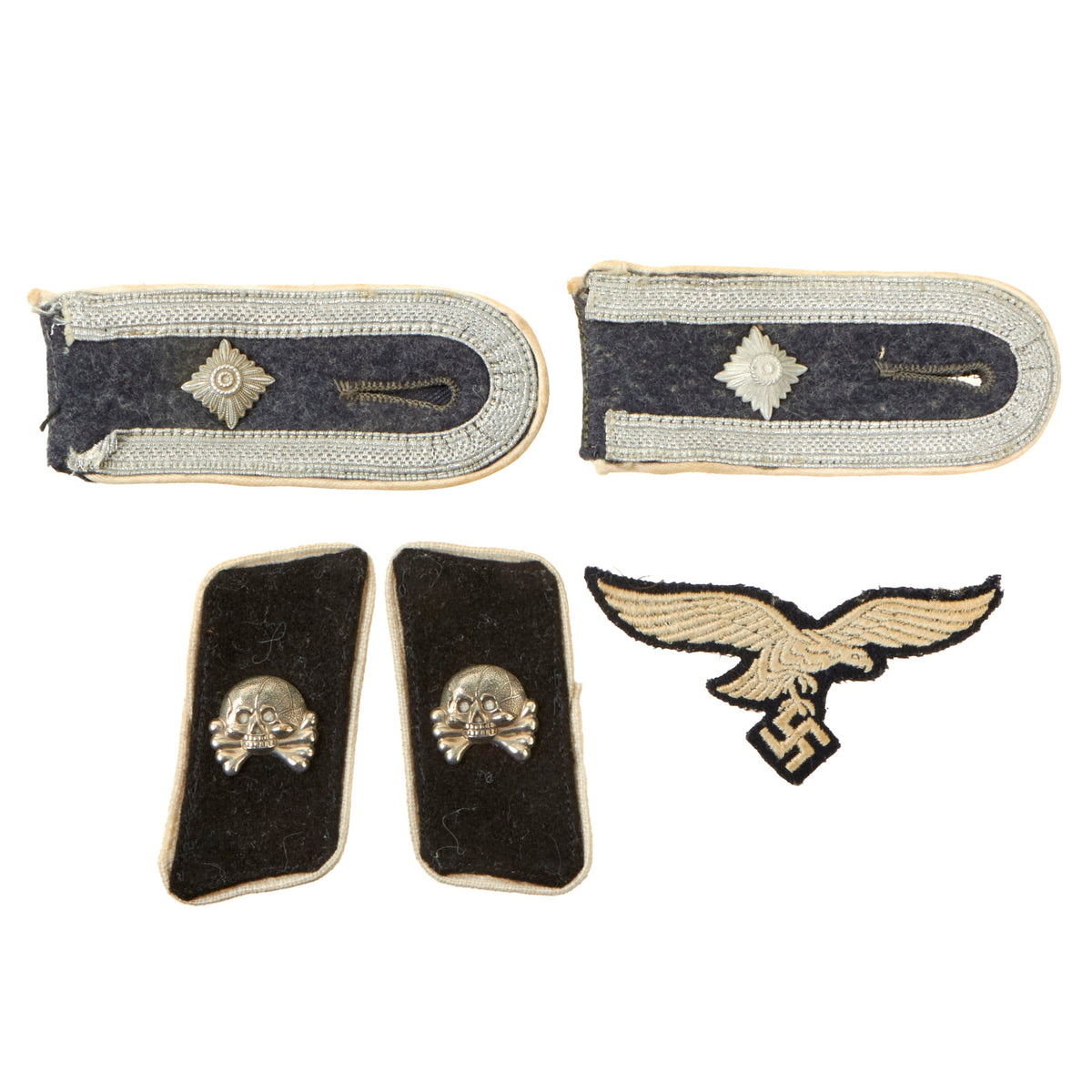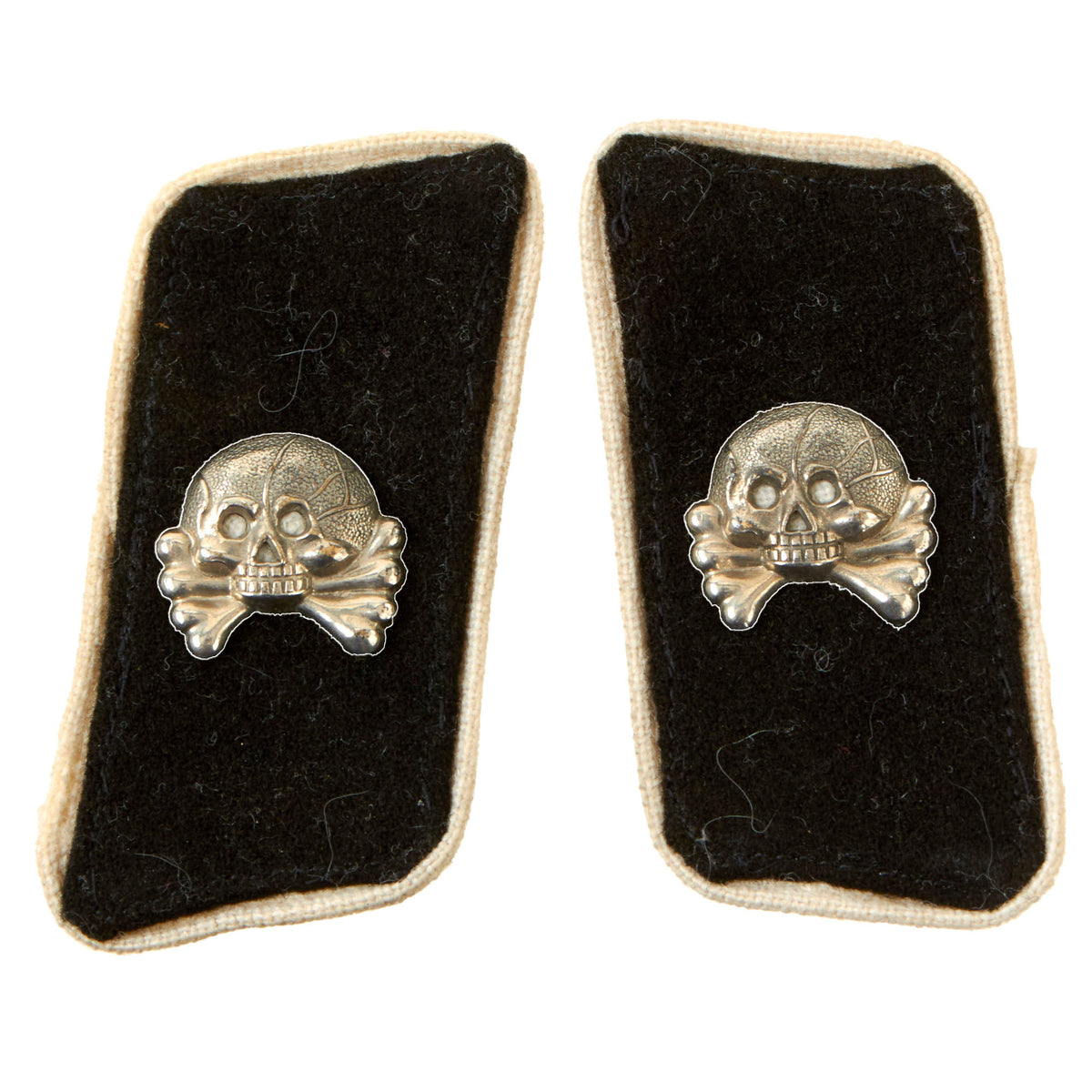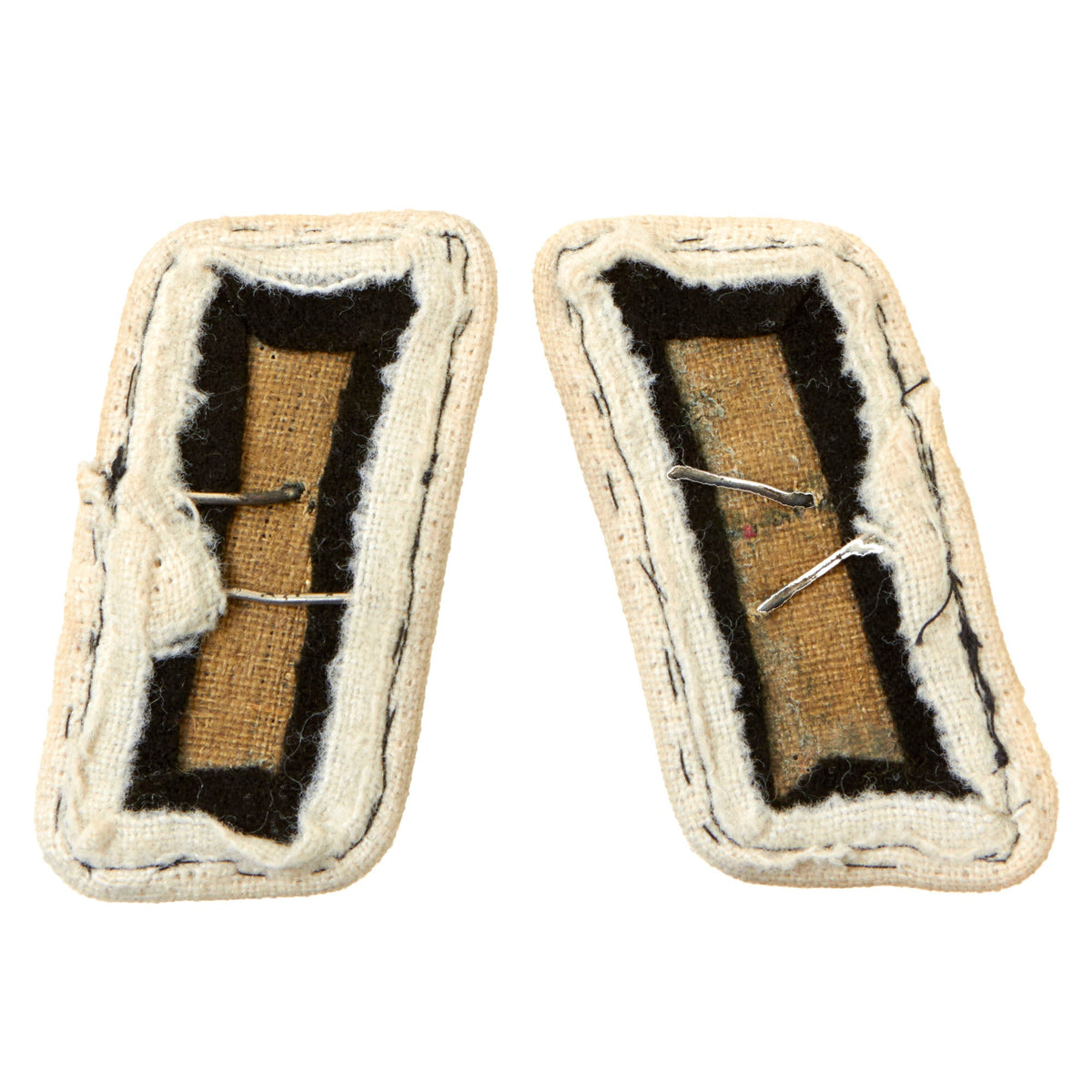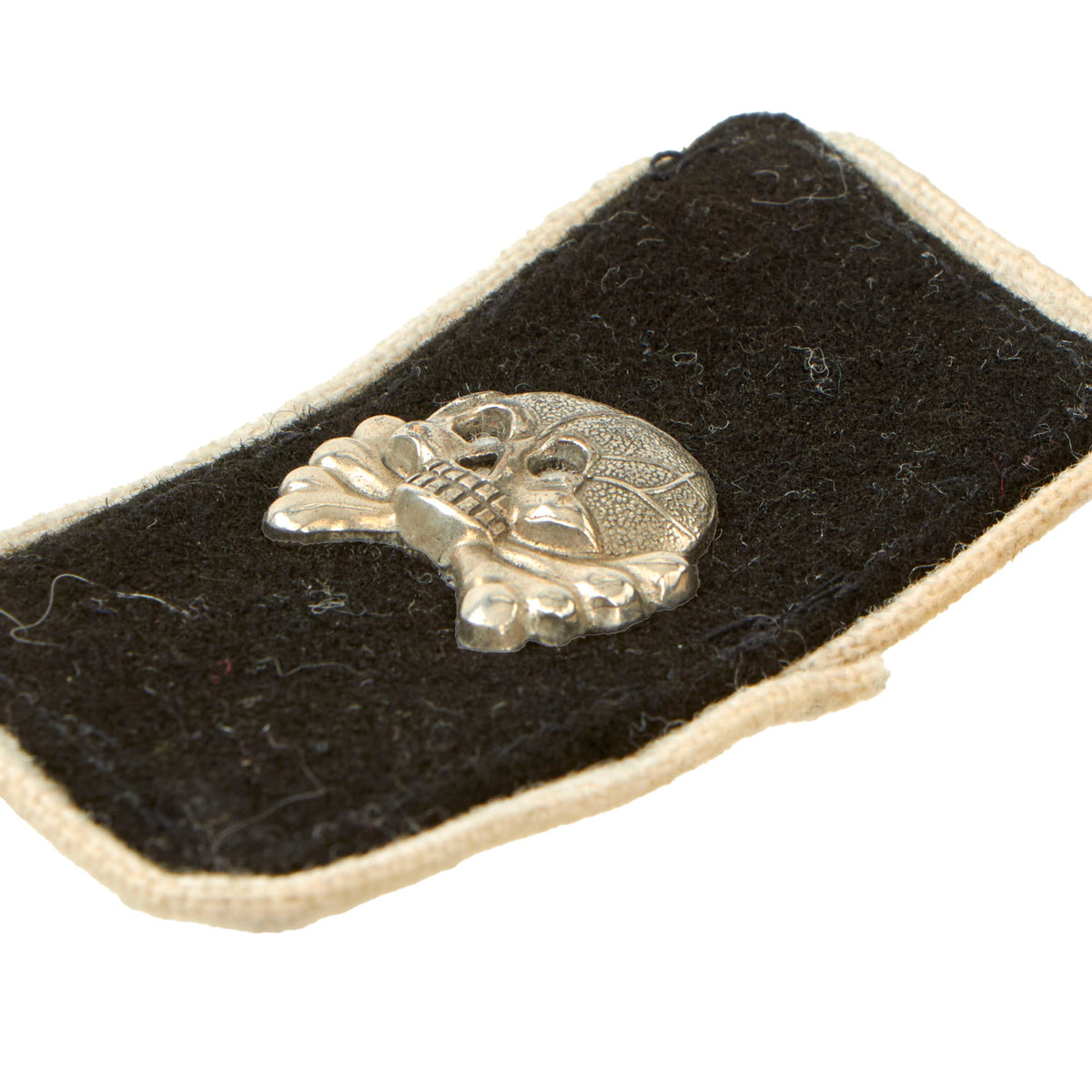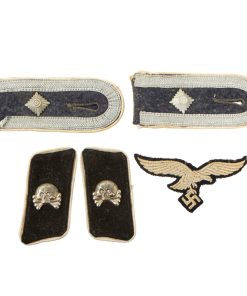Original German WWII Luftwaffe Fallschirm-Panzer Division Hermann Göring Panzer NCO Uniform Insignia Set Original Items
$ 1.495,00 $ 373,75
Original Items: Only One Set Available. Just purchased at a recent military show! This is a lovely set of Panzer NCO Insignia, as would be found on the uniform of a member of the legendary German Luftwaffe Fallschirm-Panzer Division Hermann Göring. First starting out as a regiment, the unit saw limited service in the invasion of Poland, but would later see more widespread action in the invasion of Denmark. After this it took part in the invasion of Russia as part of the 11th Panzer Division, where it performed very well before being recalled to France, where it was upgraded to full division status with the addition of numerous Panzer Armored units as Fallschirm-Panzer Division Hermann Göring.
The insignia set includes a very nice EM/NCO Luftwaffe Breast eagle, machine embroidered with light gray / silver thread on what looks to be a dark navy blue background. It is in very good condition, showing a bit of discoloration on the back due to the lacquer coating used to stabilize the weave.
Also included are a pair of very nice Panzer EM/NCO Kragenspiegel (Collar Tab) insignia, which have “Danziger” style Totenkopf (Death’s Head) insignia in the middle of a black plush material field. These are made with the usual lacquered buckram internal stiffeners, and the method of construction is totally correct. They are correctly piped with Weiß (white), the Waffenfarbe (Corps Color) for Luftwaffe General Rank officers, as well as for Division Hermann Göring, named after the Luftwaffe Reichsmarschall himself.
The button attached style NCO Schulterklappen (Shoulder flaps) have the same color piping, have the correct NCO Tresse sewn around the edge, which is open at the end. They also each have a single rank “pip”, which does not conform to the standard rank tables, but is usually attributed to a Feldwebel, equivalent to a U.S. Technical Sergeant. Most likely the owner received an upgrade in the field from Unteroffizier to Feldwebel, and did not have any tresse on hand to add the piece on the end.
A lovely Luftwaffe Fallschirm-Panzer Division Hermann Göring insignia set, ready to add to your collection!
The Fallschirm-Panzer-Division 1. Hermann Göring (1st Paratroop Panzer Division Hermann Göring – abbreviated Fallschirm-Panzer-Div 1 HG) was an elite German Luftwaffe armored division. The HG saw action in North Africa, Sicily, Italy and on the Eastern Front. The division began as a battalion-sized police unit in 1933. Over time it grew into a regiment, brigade, division, and finally was combined with the Parachute-Panzer Division 2 Hermann Göring in 1944 to form a Panzer corps under the by then Reichsmarschall. It surrendered to the Soviet Army near Dresden on May 8, 1945.
With the NSDAP seizure of 1933, Hermann Göring was appointed as Prussian Minister of the Interior. In this capacity, all Police units in Prussia came under Göring’s control. On 24 February 1933, Göring authorized the creation of a police battalion. Working in conjunction with Göring’s secret police, the Gestapo, the unit was involved in many attacks against Communists and Social democrats. In January 1934, under pressure from AH and Himmler, Göring gave Himmler’s SS control of the Gestapo. To reinforce the position of his remaining unit, Göring increased its size and instituted a military training program. During the Night of the Long Knives, the unit and Leibstandarte SS Adolf AH executed many SA leaders, removing the formation as a threat to the NSDAP.
In 1935, Göring was promoted to command of the Luftwaffe and ordered the unit transferred to the Luftwaffe, renaming it Regiment General Göring in September 1935. Two sub-units were separated from the regiment in March 1938 and redesignated German 1st Parachute Division, the first of the Fallschirmjäger (airborne) units. In 1936, the regiment was assigned for Göring’s bodyguards and as flak protection for AH’s Headquarters. The regiment participated in the annexation of Austrian (Anschluss) and the invasion of the Occupation of Czechoslovakia in 1938, and then in March 1939. During Fall Gelb, this force took part in the invasion of the Netherlands and Belgium.
During Operation Barbarossa, the regiment was attached to the 11th Panzer Division, a part of Army Group South. The regiment saw action around the areas of Radziechów, Kiev and Bryansk. In July 1942 the regiment was upgraded to brigade status, and then to full division in October 1942 as a Panzer division. While the division was in formation, the Second Battle of El Alamein had forced Field Marshal Erwin Rommel’s Afrika Korps to retreat to Tunisia. The division was sent to Tunisia piecemeal, where it eventually surrendered with the rest of Panzer Army Africa.
The reformed division was designated Panzer Division Hermann Göring and sent to Sicily. After the Allied invasion of Sicily was launched on 10 July 1943, the division was engaged at the Amphibious Battle of Gela and the Battle of Centuripe, retreating to Messina afterwards. When the armistice between Italy and Allied armed forces was signed, the division took part in the Operation Achse to disarm Italian troops. The division participated in the fighting following the Allied landing at Salerno in Operation Avalanche on 9 September. It then retreated towards the Volturno-Termoli line, and then to the Gustav Line, where it was pulled out of the line for rest and refit.
The Corps size Fallschirm-Panzerkorps Hermann Göring was created in 1944 through the combination of the unit with the Fallschirm-Panzergrenadier Division 2 Hermann Göring. After the start of the Allied offensive, Operation Diadem, on 12 May, the division retreated towards Rome and then abandoned the city. The division arrived in Poland in late-July and fought alongside SS Division Wiking and the 19th Panzer Division on the Vistula River between Modlin Fortress and Warsaw. In August, its counter-attack against the Magnaszew bridgehead, defended by the 8th Guards Army, failed after heavy fighting. Between August and September 1944, the division used captured Polish non-combatant civilians as human shields when attacking the insurgents’ positions during the Warsaw uprising. Following the destruction of the town, the division was attached to the newly formed Army Group Vistula formed 24 January 1945, defending the ruins of Warsaw in what AH termed “Festung Warschau”, or Fortress Warsaw. During the Vistula-Oder Offensive, much of the division was broken in battle.
In April, the remnants of the Hermann Göring Panzerkorps were sent to Silesia, and in heavy fighting were slowly pushed back into Saxony. On April 22, the Fallschirm-Panzer-Division 1. Hermann Göring was one of two divisions that broke through the inter-army boundary of the Polish 2nd Army (Polish People’s Army or LWP) and the Soviet 52nd Army, in an action near Bautzen, destroying parts of their communications and logistics trains and severely damaging the Polish (LWP) 5th Infantry Division and 16th Tank Brigade before being stopped two days later.
In early May, units of the corps attempted to break out towards the American forces on the Elbe, but were unsuccessful. The corps surrendered to the Red Army on 8 May 1945.
The Luftwaffe, the air force of the German military during the Third Reich, was established in 1935. Over the next 10 years, Luftwaffe troops wore a huge variety of uniforms. Enlisted men generally wore uniforms issued from military depots. Most enlisted soldiers had wool trousers and a short jacket with two internal lower pockets, called a Fliegerbluse, as well as a dressier 4-pocket tunic, the Tuchrock. Officers wore the same general uniform styles, but as officers had to supply their own uniforms, they usually wore tailor made versions. There were also myriad varieties of specialized uniforms worn by certain units or in specific situations, from the tuxedo-style “gala” formal wear uniform of the pre-war period, to the plain coveralls worn by crews of anti-aircraft cannons. There were work uniforms, tropical and summer uniforms, and camouflage clothing for airborne troops and other Luftwaffe soldiers in ground combat. Flight crews had their own specialized gear, including leather jackets and warm, electrically heated suits. Most but not all Luftwaffe uniform jackets bore the Luftwaffe emblem of a flying eagle holding a swas.
Fast Shipping with Professional Packaging
Thanks to our longstanding association with UPS FedEx DHL, and other major international carriers, we are able to provide a range of shipping options. Our warehouse staff is expertly trained and will wrap your products according to our exact and precise specifications. Prior to shipping, your goods will be thoroughly examined and securely secured. We ship to thousands clients each day across multiple countries. This shows how we're dedicated to be the largest retailer on the internet. Warehouses and distribution centres can be located throughout Europe as well as the USA.
Note: Orders with more than one item will be assigned a processing date depending on the item.
Before shipping before shipping, we'll conduct a thorough inspection of the items you have ordered. Today, the majority of orders will be delivered within 48 hours. The delivery time will be between 3-7 days.
Returns
The stock is dynamic and we cannot completely manage it because multiple stakeholders are involved, including our factory and warehouse. So the actual stock may alter at any time. It's possible that you may not receive your order once the order has been made.
Our policy is valid for a period of 30 days. If you don't receive the product within 30 days, we are not able to issue a refund or an exchange.
You can only return an item if it is unused and in the same state as the day you received it. You must have the item in its original packaging.
Related products
Uncategorized
Uncategorized
Uncategorized
Armored Burgonet Helmet & Polearm from Scottish Castle Leith Hall Circa 1700 Original Items
Uncategorized
Uncategorized
Uncategorized
Uncategorized
Angolan Rebel 1970s era 60mm Inert Display Mortar from Angolan Civil War Original Items
Uncategorized
Uncategorized
Uncategorized
Uncategorized
Uncategorized
Uncategorized
Uncategorized
Uncategorized
Uncategorized
Uncategorized
